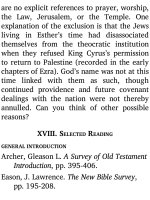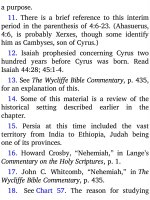Jensens survey of the old testament adam 116
Bạn đang xem bản rút gọn của tài liệu. Xem và tải ngay bản đầy đủ của tài liệu tại đây (79.54 KB, 4 trang )
2. Building and furnishings
3. Dedication (8:1—9:9)
(6:1—7:51)
C. SOLOMON’S LAST YEARS
This is a study of contrasts:
1. The prosperity of the kingdom
(9:10—
10:29)
2. The apostasy of the king
(11:1-43)
In fame and wisdom, riches and honor,
position and popularity, Solomon exceeded
all the kings of the earth. These things won
his heart, and he forgot the Lord, who really
was the One who had given him every good
thing he had. The last part of Solomon’s life
was a tragedy. Carl De Vries comments that
“his gradual apostasy had more disastrous
results than the infamous scandal of his
father, who sincerely repented.”3
D. SPLIT OF THE KINGDOM
chapter 12 of 1 Kings is a key chapter in
the Old Testament, because it records the
event which steered the course of God’s
people through the remainder of the Old
Testament days. Study the chapter carefully.
Before the event of the kingdom’s split,
there were occasions of hostility between
the northern tribes (“men of Israel”) and the
southern tribes (“men of Judah”). (Read 2
Sam 19:40-43.) Solomon’s excessive taxation
of the people stirred up such discontent that
shortly after his death the ten northern
tribes revolted against the authority of
Solomon’s son Rehoboam, and formed
another kingdom, known thereafter as Israel.
The two tribes which remained true to
Rehoboam were known as Judah (see Map
L). This was the beginning of the divided
kingdom. Who was king of the northern
group?
In the rst eleven chapters of 1 Kings the
narrative runs smoothly because only one,
kingdom (all the tribes of the united or
undivided kingdom) is involved. From 1
Kings 12 to 2 Kings 17, however, with the
two kingdoms (Israel, north and Judah,
south) existing side by side, the account
reads with more di culty, because the
author has chosen to shift the narrative from
the one kingdom to the other, in order to
synchronize the histories. Then at 2 Kings 18
to the end, there is a return to the smooth
ow again, since only the one surviving
kingdom
(Judah)
is
involved.
This
alternation of kingdoms in the narrative of 1
Kings 12-22 is shown by the following
outline:4
I. The Kingdom of Judah (12:1-19).
A.
Accession
and
Folly
of
Rehoboam (12:1-15; cf. 2
Chron 10:1-11).
B.
Rebellion of the Ten Tribes
(12:16-19; cf. 2 Chron 10:1219 11:1-4).
II. The Kingdom of Israel (12:20—14:20).
A.
Accession and Sin of Jeroboam
(12:20-33).
B.
God’s Interposition (13:1-32).
C.
Jeroboam’s Continued Sin and
God’s Message (13:33—14:18).
D.
Jeroboam’s Death (14:19-20).
III. The Kingdom of Judah (14:21—
15:24).
A.
Judah’s Sin and Idolatry (14:2124; cf. 2 Chron 12:1).
B.
God’s Chastisement and Mercy
(14:25-30; cf. 2 Chron 12:2-12).
C.
Death of Rehoboam (14:31; cf. 2
Chron 12:13-16).









